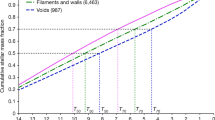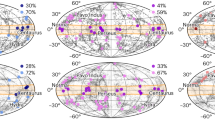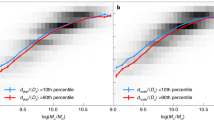Abstract
Galaxies congregate in clusters and along filaments, and are missing from large regions referred to as voids. These structures are seen in maps derived from spectroscopic surveys1,2 that reveal networks of structure that are interconnected with no clear boundaries. Extended regions with a high concentration of galaxies are called ‘superclusters’, although this term is not precise. There is, however, another way to analyse the structure. If the distance to each galaxy from Earth is directly measured, then the peculiar velocity can be derived from the subtraction of the mean cosmic expansion, the product of distance times the Hubble constant, from observed velocity. The peculiar velocity is the line-of-sight departure from the cosmic expansion and arises from gravitational perturbations; a map of peculiar velocities can be translated into a map of the distribution of matter3. Here we report a map of structure made using a catalogue of peculiar velocities. We find locations where peculiar velocity flows diverge, as water does at watershed divides, and we trace the surface of divergent points that surrounds us. Within the volume enclosed by this surface, the motions of galaxies are inward after removal of the mean cosmic expansion and long range flows. We define a supercluster to be the volume within such a surface, and so we are defining the extent of our home supercluster, which we call Laniakea.
This is a preview of subscription content, access via your institution
Access options
Subscribe to this journal
Receive 51 print issues and online access
$199.00 per year
only $3.90 per issue
Buy this article
- Purchase on Springer Link
- Instant access to full article PDF
Prices may be subject to local taxes which are calculated during checkout


Similar content being viewed by others
References
de Lapparent, V., Geller, M. J. & Huchra, J. P. A slice of the universe. Astrophys. J. 302, L1–L5 (1986)
Gott, J. R., III et al. A map of the universe. Astrophys. J. 624, 463–484 (2005)
Courtois, H. M. et al. Cosmography of the local universe. Astron. J. 146, 69 (2013)
Strauss, M. A. et al. A redshift survey of IRAS galaxies. IV — The galaxy distribution and the inferred density field. Astrophys. J. 385, 421–444 (1992)
Dekel, A. et al. IRAS galaxies versus POTENT mass: density fields, biasing, and omega. Astrophys. J. 412, 1–21 (1993)
Kitaura, F.-S. et al. Cosmic structure and dynamics of the local Universe. Mon. Not. R. Astron. Soc. 427, L35–L39 (2012)
Courtois, H. M. et al. Three-dimensional velocity and density reconstructions of the local universe with Cosmicflows-1. Astrophys. J. 744, 43 (2012)
Zaroubi, S. et al. Wiener reconstruction of the large-scale structure. Astrophys. J. 449, 446–459 (1995)
Zaroubi, S., Hoffman, Y. & Dekel, A. Wiener reconstruction of large-scale structure from peculiar velocities. Astrophys. J. 520, 413–425 (1999)
Doumler, T. et al. Reconstructing cosmological initial conditions from galaxy peculiar velocities — II. The effect of observational errors. Mon. Not. R. Astron. Soc. 430, 902–911 (2013)
Fixsen, D. J. et al. The cosmic microwave background spectrum from the full COBE FIRAS data set. Astrophys. J. 473, 576–587 (1996)
Raychaudhury, S. The distribution of galaxies in the direction of the ‘Great Attractor’. Nature 342, 251–255 (1989)
Hoffman, Y. et al. The large-scale tidal velocity field. Preprint at http://arXiv.org/abs/astro-ph/0102190 (2001)
Hoffman, Y. et al. A kinematic classification of the cosmic web. Mon. Not. R. Astron. Soc. 425, 2049–2057 (2012)
Haynes, M. P. & Giovanelli, R. in Large-Scale Motions in the Universe: A Vatican Study Week (eds Rubin, V. C. & Coyne, G. V. ) 31–70 (Princeton Univ. Press, 1988)
Dekel, A. et al. POTENT reconstruction from mark III velocities. Astrophys. J. 522, 1–38 (1999)
Dressler, A. et al. Spectroscopy and photometry of elliptical galaxies — a large-scale streaming motion in the local universe. Astrophys. J. 313, L37–L42 (1987)
de Vaucouleurs, G. Evidence for a local supergalaxy. Astron. J. 58, 30–32 (1953)
Tully, R. B. et al. Cosmicflows-2: the data. Astron. J. 146, 86 (2013)
Sorce, J. G., Tully, R. B. & Courtois, H. M. The mid-infrared Tully-Fisher relation: calibration of the type Ia supernova scale and H0 . Astrophys. J. 758, L12 (2012)
Planck Collaboration. et al. Planck intermediate results. XVI. Profile likelihoods for cosmological parameters. Available at http://adsabs.harvard.edu/abs/2013arXiv1311.1657P (2013)
Riess, A. G. et al. A 3% solution: determination of the Hubble constant with the Hubble Space Telescope and Wide Field Camera 3. Astrophys. J. 730, 119 (2011)
Freedman, W. L. et al. Carnegie Hubble Program: a mid-infrared calibration of the Hubble constant. Astrophys. J. 758, 24 (2012)
Courtois, H. M. et al. Three-dimensional velocity and density reconstructions of the local universe with Cosmicflows-1. Astrophys. J. 744, 43 (2012)
Zaroubi, S., Hoffman, Y. & Dekel, A. Wiener reconstruction of large-scale structure from peculiar velocities. Astrophys. J. 520, 413–425 (1999)
Strauss, M. A. & Willick, J. A. The density and peculiar velocity fields of nearby galaxies. Phys. Rep. 261, 271–431 (1995)
Zaroubi, S. et al. Wiener reconstruction of the large-scale structure. Astrophys. J. 449, 446–459 (1995)
Pomarède, D. et al. Interactive visualization of astrophysical plasma simulations with SD-vision. Astron. Soc. Pacif. Conf. Ser. 385, 327 (2008)
Jarrett, T. H. et al. 2MASS Extended Source Catalog: overview and algorithms. Astron. J. 119, 2498–2531 (2000)
Acknowledgements
We thank our many collaborators in the accumulation of Cosmicflows-2 distances. We thank the CLUES collaboration, and in particular S. Gottlöber and J. Sorce in connection with the analysis. T. Jarrett provided an unpublished 2MASS Extended Source Catalog redshift compendium, the only all-sky redshift catalogue extensive enough to match the region of our reconstruction. The narration in the Supplementary Video is by S. Anvar and the original music is played by N.-E. Pomarède. The name ‘Laniakea’ was suggested by N. Napoleon, Kapiolani Community College, Hawaii. Financial support was provided by US National Science Foundation award AST09-08846, several awards through the Space Telescope Science Institute for observing time with Hubble Space Telescope, an award from the Jet Propulsion Lab for observations with Spitzer Space Telescope, and NASA award NNX12AE70G for analysis of data from the Wide-field Infrared Survey Explorer. We also acknowledge support from the Israel Science Foundation (1013/12) and the Lyon Institute of Origins under grant ANR-10-LABX-66 and the CNRS under PICS-06233.
Author information
Authors and Affiliations
Contributions
R.B.T. guided the project, was involved in the data acquisition, interacted closely in the development of the ideas that are presented here, and wrote most of the Letter. H.C. was involved in the observing programme, was instrumental in coordinating activities, and was involved in all facets. Y.H. took responsibility for the theoretical analysis, including the Wiener filter, the cosmic web and the Malmquist bias correction. D.P. developed and applied visualization tools useful to this research.
Corresponding author
Ethics declarations
Competing interests
The authors declare no competing financial interests.
Extended data figures and tables
Extended Data Figure 1 Structure within a cube extending 16,000 km s−1 (∼200 Mpc) on the cardinal axes from our position at the origin.
Densities on a grid within the volume are determined from a Wiener filter reconstruction based on the observed velocity field. Three isodensity contours are shown. The density map is detailed near the centre of the box where observational constraints are dense and accurate, but tapers to the mean density as constraints weaken. Nevertheless, velocity flows illustrated by the black threads are defined on large scales. Ultimately all flows appear to drain towards Shapley, although flows through the Perseus–Pisces filament take a circuitous route through the poorly studied Lepus region.
Extended Data Figure 2 A representation of structure and flows due to mass within 6,000 km s−1 (∼80 Mpc).
Surfaces of red and blue respectively represent outer contours of clusters and filaments as defined by the local eigenvalues of the velocity shear tensor determined from the Wiener filter analysis. Flow threads originating in our basin of attraction that terminate near the Norma cluster are in black, and adjacent flow threads that terminate at the relative attractor near the Perseus cluster are in red. The Arch and extended Antlia Wall structures bridge between the two attraction basins. The arch is part of a wall surrounding the Local Void.
Extended Data Figure 3 One of three orthogonal views that illustrate the limits of the Laniakea supercluster.
This SGX–SGY view at SGZ = 0 extends the scene shown in Fig. 2 with the addition of dark blue flow lines away from the Laniakea local basin of attraction, and also includes a dark swath at SGY = 0 showing the region obscured by the plane of the Milky Way. As in Fig 2 in the main text, the orange contour encloses the inflowing streams, hence, defines the limits of the Laniakea supercluster containing the mass of 1017 Suns and 100,000 large galaxies.
Extended Data Figure 4 The second orthogonal view that illustrates the limits of the Laniakea supercluster.
This is an SGY–SGZ slice at SGX = −4,750 km s-1: the dark swath indicates the region obscured by the Milky Way.
Extended Data Figure 5 The third orthogonal view that illustrates the limits of the Laniakea supercluster.
Here we show an SGX–SGZ slice at SGY = +1,000 km s−1. The Milky Way lies essentially in a plane parallel to the slice, at SGY = 0.
Supplementary information
Supplementary Information
This file contains the transcript for Supplementary Video 1. (PDF 124 kb)
Laniakea Supercluster of Galaxies
By steps, the video illustrates the observed local distribution of galaxies, the observed departures from the expansion of the universe of the fraction of the galaxies with distance measurements, the inferred three-dimensional flow pattern of the local galaxies, and the inferred underlying distribution of matter causing these flows. Flows are differentiated between motions inward toward a local basin of attraction and flows outward toward external attractors. A boundary is located between inward and outward flows. We call the contiguous region of the inward flow pattern the Laniakea Supercluster of galaxies, our home supercluster. For a high resolution version of this video please follow this link http://irfu.cea.fr/laniakea or http://vimeo.com/pomarede/laniakea. (MP4 30607 kb)
PowerPoint slides
Rights and permissions
About this article
Cite this article
Tully, R., Courtois, H., Hoffman, Y. et al. The Laniakea supercluster of galaxies. Nature 513, 71–73 (2014). https://doi.org/10.1038/nature13674
Received:
Accepted:
Published:
Issue Date:
DOI: https://doi.org/10.1038/nature13674
This article is cited by
-
Cosmological Distance Scale. Part 14: “Hubble Bubble” and the Gravitational Dipole
Measurement Techniques (2023)
-
Exploring diffuse radio emission in galaxy clusters and groups with uGMRT and SKA
Journal of Astrophysics and Astronomy (2023)
-
Cosmological Distances Scale. Part 15: Cosmic Jerk and Gravitational Dipole of Inhomogeneity
Measurement Techniques (2023)
-
Nanoclusters as Synthons for Unit-Cell-Size Comparable One-Dimensional Nanostructures
Chemical Research in Chinese Universities (2023)
-
Educational Design Framework for a Web-Based Interface to Visualise Authentic Cosmological “Big Data” in High School
Journal of Science Education and Technology (2021)
Comments
By submitting a comment you agree to abide by our Terms and Community Guidelines. If you find something abusive or that does not comply with our terms or guidelines please flag it as inappropriate.



